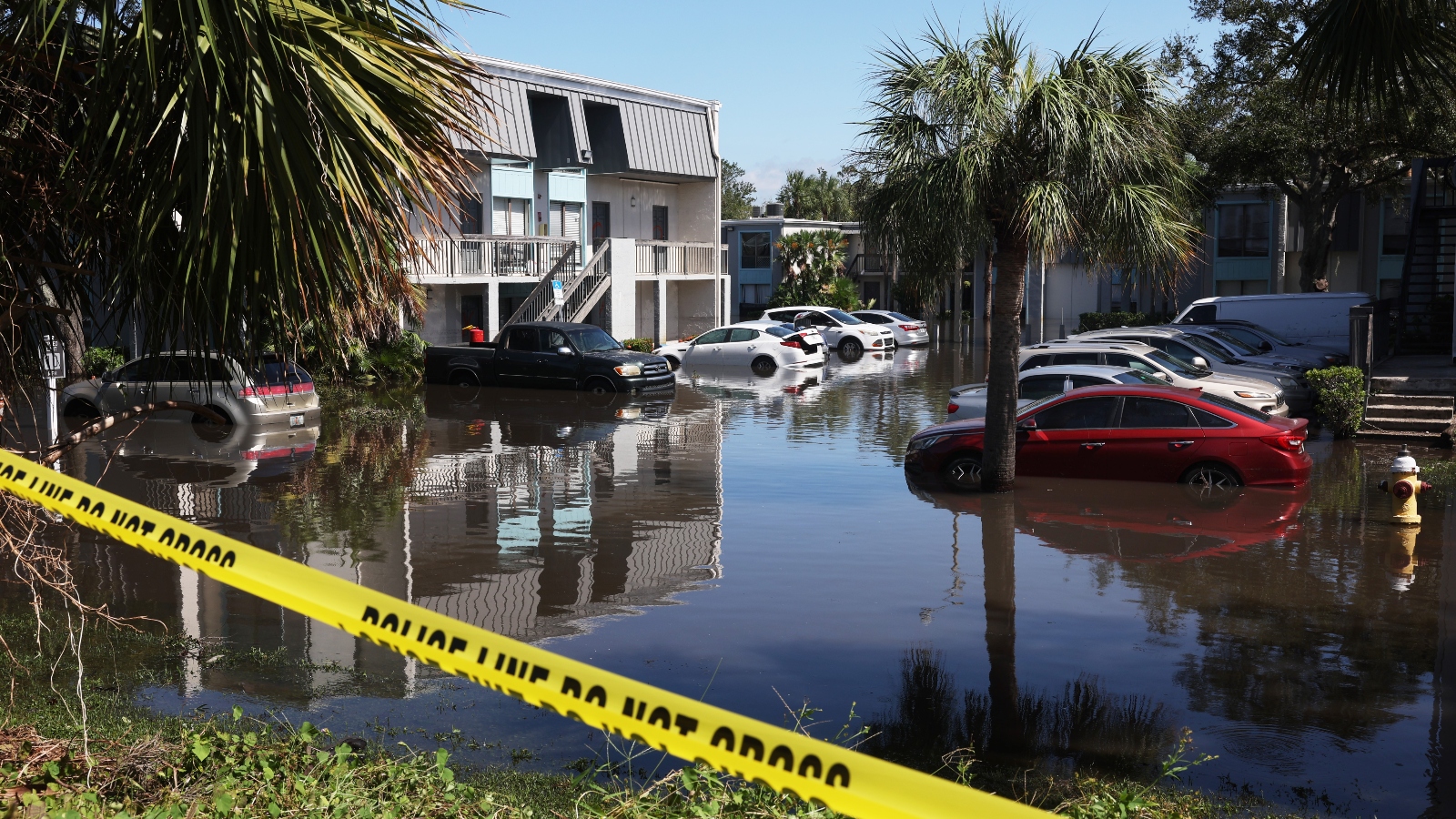This story was first published st louis public radio.
In the early morning hours of Election Day, highways in the St. Louis area were flooded. A severe storm battered Missouri over several days, dumping 6 to 10 inches of rain, a record amount for November.
died in flash flood at least 5 peopleTwo of them were elderly poll workers whose cars were swept off state highways.
Mayors along the Mississippi River have spent years watching intensifying storms and flooding wreak havoc on their communities.
Grafton, Illinois, for example, avoided flash flooding on Election Day, but sustained $160,000 to $170,000 in damage from July’s heavy rains. The town’s main intersections were blocked with logs and debris, water pipes were blown out by the storm, and streets needed repairs.
However, Grafton did not have a federal disaster declaration and was not eligible for assistance from the Federal Emergency Management Agency (FEMA). Instead, it paid for road and water repairs through the Department of Public Works’ annual budget. As a result, the city was unable to purchase new snow removal trucks as planned this fiscal year.
“What this means is we’re going to spend another year limping along and keeping the cars moving,” said Grafton, the mayor who oversees a $1.2 million annual budget for the small riverside city of about 600 people. said Michael Morrow.
River communities suffered repeated losses. But federal disaster funds can take weeks, months, or even years to be disbursed. Traditional insurance programs are tied to property, require proof of loss for payment, and can be cumbersome and time-consuming to assemble.
So this fall, Mississippi River Cities and Towns Plan (MRCTI) has announced a new insurance pilot in the hope of more effectively supporting the recovery of riverside towns.
MRCTI represents 105 cities along 10 major states in the Mississippi River Basin. munich rea German multinational insurance company created an insurance product.
The resulting pilot will test a new type of insurance pool, called parametric insurance, designed to quickly fund emergency response after natural disasters such as floods.
Piloting the usefulness of new “parametric” insurance contracts
Possible causes are: Intensification of heavy rains and flooding According to , it’s anthropogenic climate change. The Fifth National Climate Assessment is a scientific report prepared every four years for the U.S. Congress and President. Impacts, risks and vulnerabilities associated with global climate change.
In 2019, communities across the basin experienced months of flooding across the Mississippi, Missouri, and Arkansas rivers. Reported losses totaled about $25 billion in at least 17 states, according to the National Oceanic and Atmospheric Administration.
The central United States is emerging as a new flash flood hotspot, according to a study published in Nature. Communication Earth and Environment journal. Their new role as hotspots is creating more disaster damage and the need for insurance to deal with it.
While traditional liability insurance requires the insured owner to prove a specific loss by gathering evidence and presenting pre-storm documentation, parametric insurance requires the insured owner to prove a specific loss by gathering evidence and presenting pre-storm documentation, whereas parametric insurance requires the insured owner to prove specific losses by gathering evidence and presenting pre-storm documentation, while parametric insurance requires Payments are made as soon as an agreed-upon “trigger” reaches a certain level.
Brent Jones / St. Louis Public Radio
Munich Re proposed that the MRCTI pilot use U.S. Geological Survey watershed data to determine the best gauges to measure flood depths along rivers. Payments begin when the river flood reaches a certain depth.
Cathy Bowman McLeod, CEO of Climate Resilience for All, a nonprofit organization focused on climate change adaptation, said it was important to get the trigger right.
“You need to have a good understanding of how and why you set triggers in certain locations,” she said. “It takes a lot of engagement to make sure everyone is on the same page about what the product is, how it works, and what the triggers should be.”
The goal of Munich Re’s pilot program is to demonstrate in real time how parametric insurance payment policies perform in current insurance market conditions and how rapid payments can support disaster response in cities immediately following a flood. It’s about proving it.
First, Munich Re plans to create a mock-up of an insurance policy for one peril, floods, with the understanding that multiple perils, such as extreme heat or drought, may be added later. said Colin Wellenkamp, MRCTI Executive Director. Newly elected as of November 6th State Representative for Missouri District 105.
The mock-up calculates different premium costs and theoretical payment options available for cities of different sizes along the river. But implementing the test won’t cost the city a dime, and nothing will be paid until the test is implemented. The pilot and final product are in early stages of development, so it’s unclear which company will ultimately pay for them.
Once Munich Re goes into effect, each city government will hold the policy and receive payments. Wellenkamp said he hopes to persuade large companies that depend on healthy and functioning Mississippi River hydrology to accept a premium.
Prompt payments could ease the burden on cities.
“In the first 24 to 72 hours after a disaster, a little bit of money can help so much,” Wellenkamp said. “We will use that time to evacuate and then move people away from further damage.”
But soon after the initial emergency response, municipalities begin looking for funding for long-term cleanup and restoration. Under the current paradigm, accessing that funding can be difficult.
In spring 2019, major Mississippi River flooding flooded many communities, including Grafton, partially closing downtown and forcing people to evacuate.
The Trump administration did not declare a major disaster until September of that year, months after the floodwaters had receded. Moreau said it took until 2022 for federal funding to reach Grafton.
“The previous administration went through that flood,” Morrow said. “I’m mayor now and I received some of the money they put in years ago.”

Auto insurance premiums are rising due to abnormal weather caused by climate change
That wait time puts stress on city finances, especially smaller cities like Grafton, Morrow added.
Traditional insurance doesn’t necessarily help either. The City of Grafton has a flood policy, but it only covers land owned by the City. Local residents and businesses will need to take their own flood countermeasures. The National Flood Insurance Program (NFIP), which underwrites many flood insurance policies, has various coverage limits. For example, the NFIP does not cover roads or wastewater infrastructure.
Additionally, since this insurance covers certain types of damage, such as certain buildings and their contents, proof of loss will also be required before a check can be issued. This “evidence” takes several days to document and is slow to process, delaying local authorities from being able to quickly begin repairs. Without proper pre-storm documentation, proving damage can be nearly impossible.
Parametric insurance – which works with measurable triggers and is not tied to documentable losses – could ease the process.
Cities from the Mississippi River’s headwaters to its mouth could buy into this policy, creating a pool that spreads out the risks faced by individual communities.
“Not all cities will experience flooding every year, but flooding will affect at least some sections of the river,” said Raghuvir Vinukol, head of climate insight and advisory at Munich Re in the US. .
He added that the insurance pool would protect the town from the risk of ruin and make the town more resilient through faster reinvestment in infrastructure with more timely payments.
Parametric Insurance for the Mississippi Delta and Beyond
In the case of river flooding, this type of insurance risk pool is new territory, Vinukol said. He said the insurance industry is working with many communities to respond to evolving needs as climate risks become more acute.
parametric insurance still under developmentone early example stands out to Vinukol. Caribbean Catastrophe Risk Insurance System (CCRIF).
CCRIF pools the risk of Caribbean countries that face hurricane risk each year. By pooling the risk, each island can receive a larger payout than if it were insured individually.
In July, just 14 days after Hurricane Beryl destroyed 90% of buildings and agriculture on Carriacou and Petit Martinique, the Government of Grenada received its first grant from CCRIF for disaster recovery funding.
Tropical cyclone policy is $42 million to Grenadathe largest single payment from CCRIF since its inception in 2007.
Vinukol hopes to apply this type of shared risk pool in the Mississippi River Basin to insure cities at risk of inland flooding.

Floods force home reckoning in Vermont
“The triggers are different, the dangers are different, but the concept is the same,” Vinukol said.
Located near the end of the Mississippi River, New Orleans is not immune to the devastating effects of extreme weather events. Some municipal educational institutions, including NOLA Public Schools, purchase parametric insurance to protect critical infrastructure.
One of the first tests of these policies occurred in September when Hurricane Francine’s storm surge, rain, and winds battered southern Louisiana.
However, NOLA Public Schools did not receive payments from its contract with Swiss Re.
Wind speeds were high, but not fast enough to meet the policy’s standard of more than 160 miles per minute.
Because New Orleans is more likely to repeatedly experience severe losses from named storms than upper-basin cities such as Minneapolis, cities closer to the Gulf Coast could end up with higher insurance rates once the policy is formally rolled out. Wellenkamp said he could end up paying a fee. MRCTI.
Wellenkamp said cities that choose to cover more perils or lower-level perils may pay higher premiums because that can lead to more frequent payments. Local governments could end up paying for things like Grafton’s July floods and St. Louis’ Election Day storms.
McLeod argues that communities should not expect payments from parametric insurance so often. “Due to the nature of the product, you shouldn’t do that.” [pay every year]” she said. “Insurance prepares you for the worst.”
Munich Re advises that parametric insurance is best complemented rather than replacing traditional insurance contracts. However, company officials believe these new policies provide an opportunity for insurance to adapt to changing risk conditions as weather events become more extreme.
Despite its potential to facilitate faster disaster response, parametric insurance is not a silver bullet, said McLeod of Climate Resilience for All.
For her, the best solution is to reduce the potential risks from climate change.
“In the big picture, this is a very important tool in financing and managing climate change risks, and we need all the tools,” she said.
But McLeod said the most effective financial step, rather than any new financial instruments, would be to address the root causes of climate change and build or rebuild more nature protections, such as wetlands. Ta.
“We have to reduce risk. [or] You can’t afford to insure it,” she said. “Knowing something like this will happen doesn’t cover you.”
The Lens’ Marta Jewson contributed reporting to this article.
This story is Mississippi River Basin Agriculture and Water Deskan independent reporting network based in . University of Missouri. Disclosure: Both Desk and MRCTI are funded by the Walton Family Foundation. Support independent reporting networks Donation.







